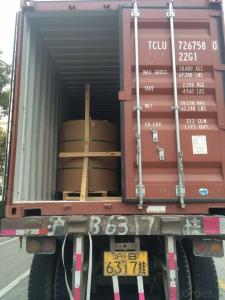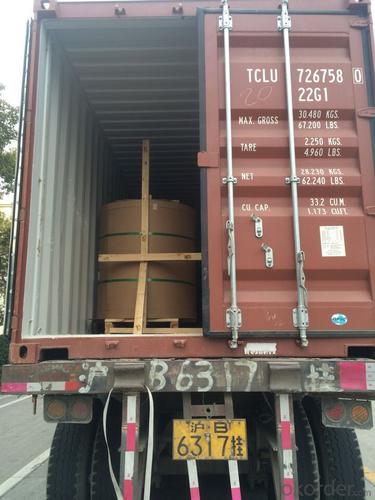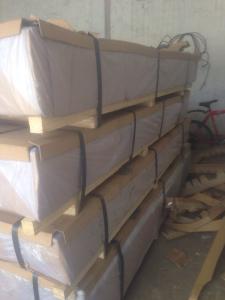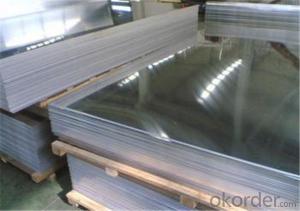Lowes 16 Gauge Thick Aluminum Sheets - Aluminium Mill Finish Sheet with Better Price in Our Warehouse
- Loading Port:
- Shanghai
- Payment Terms:
- TT OR LC
- Min Order Qty:
- 9 m.t.
- Supply Capability:
- 5000 m.t./month
OKorder Service Pledge
OKorder Financial Service
You Might Also Like
Specification
1.Structure of Product Description
cold rolled aluminumnish aluminum plate are both widely used in the field of construction field and decoration field, etc.
There are many different grades, such as: 1000 series,5000 series,7000series, 8000 series, etc. The Exactly Alloy and temper and other details are as follows: 1000 series, etc.
1050,1060,1100, 2024, 3003, 5052,5754,5083,6061,6063,8011, etc.
The temper is include H14, H22,H114,etc.
2. Main features of the product
a. best price.
c. Shortest service.
3. Image.
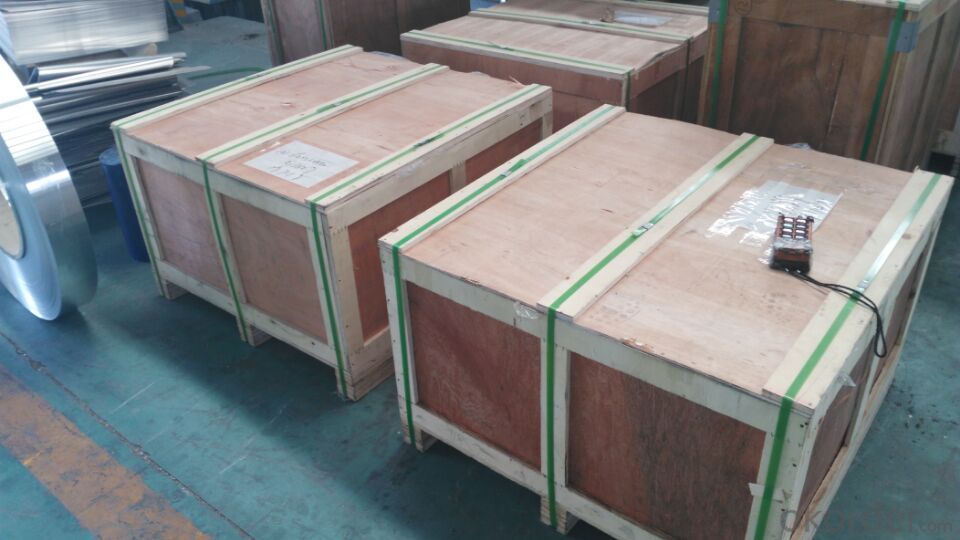
4. Product detailed sizes:
1000mm*2000mm,1250mm*2500mm,1219mm*2438mm,1500mm*3000mm, etc.
5. FAQ:
What is the quality standard?
---Usually our standard is GB3880-2006 or others.
What is the width range?
---It is from 500mm-1500mm, etc.
What is the length range:
---It is from 200mm to 6000mm, etc.
What is the MOQ for your products yet?
---Normally it is around 11 tons/each size.
How many tons did you export in one year?
---Normally it is around 30000 tons totally.
Where is your client from?
---Normally it is from UAE, Saudi Arabia, England,Turkey,Japan, etc.
What is your mainly products?
---Normally the mainly products are as follows: hot rolled and cold rolled aluminum sheet,big-5-bar aluminium checkered sheet,small-5-bar aluminium mirror finish aluminium sheet, aluminum casting coil, etc.
- Q: What are the different methods for perforating aluminum sheets?
- There are several methods for perforating aluminum sheets, including laser cutting, punching, drilling, and waterjet cutting. Each method has its own advantages and is chosen based on factors such as desired hole size, shape, precision, and production volume.
- Q: How does the surface finish affect the optical properties of aluminum sheet?
- The optical properties of aluminum sheet are significantly influenced by its surface finish. Optimal light reflection and minimal scattering are achieved with a smooth surface finish, leading to heightened reflectivity. Consequently, this amplifies the brightness and reflectiveness of the aluminum sheet. Conversely, a rough or textured surface finish on aluminum sheet provokes light scattering in various directions, thereby diminishing reflectivity. Consequently, this yields a lackluster and less reflective appearance. Furthermore, the surface finish has an impact on the visual aspect of any coatings or films applied to the aluminum sheet. A smooth surface finish promotes superior adhesion and uniformity of coatings, thus augmenting their optical properties. To conclude, the optical properties of aluminum sheet are improved with a smooth surface finish, as it enhances reflectivity and diminishes scattering, ultimately resulting in a more vibrant and reflective appearance.
- Q: Are aluminum sheets suitable for laser cutting?
- Yes, aluminum sheets are suitable for laser cutting. Aluminum is a commonly used material in laser cutting due to its excellent reflective properties, high thermal conductivity, and low melting point. These characteristics make it an ideal material to be cut by a laser beam. Laser cutting provides precise and clean cuts on aluminum sheets, allowing for intricate designs and complex shapes to be easily achieved. Additionally, laser cutting of aluminum sheets is a fast and efficient process, offering high productivity and cost-effectiveness.
- Q: Are aluminum sheets resistant to chemicals?
- Yes, aluminum sheets are generally resistant to many chemicals. Aluminum has a natural oxide layer on its surface that provides a protective barrier against corrosion and chemical reactions. This oxide layer is stable and resists most acids, alkalis, and organic solvents. However, aluminum can be corroded by certain chemicals, such as strong acids or bases, and some halogenated compounds. Additionally, prolonged exposure to certain chemicals or extreme conditions may weaken the oxide layer and make aluminum more susceptible to corrosion. Therefore, while aluminum sheets are generally resistant to chemicals, it is important to consider the specific chemical environment and potential interactions before using aluminum in certain applications.
- Q: i need to know these things please....can aluminium withstand the forces of being in a cargo hold on a air freight, can it withstand extreme temps and to what extent an is it microwavable?? please help me
- No metals are microwavable, they will ruin any microwave oven by producing sparks. Even ceramic plates with a little metallic paint eg of silver will spark. Aluminium on its own has little strength but when mixed with small amounts of eg copper or manganese it aquires great strength while remaining light. In addition it has the advantage of being very resistant to oxidation and corrosion. It is certainly used extensively in aircraft construction. Due to being non toxic it used to make cans for beers, soft drinks (sodas) etc However it doesn't stand up well to high temperatures, its melting point is just at 660 degrees celsius, by comparison for iron it is 1540 and tungsten 3420.
- Q: Are the aluminum sheets suitable for manufacturing solar reflectors?
- Yes, aluminum sheets are suitable for manufacturing solar reflectors. Aluminum is a highly reflective material that can efficiently reflect sunlight, making it an ideal choice for solar reflectors. It has a high reflectivity and low emissivity, allowing it to reflect a significant amount of solar radiation while minimizing heat absorption. Additionally, aluminum is lightweight, durable, and corrosion-resistant, making it suitable for outdoor applications. Its flexibility also allows for easy shaping and forming into various reflector designs. Overall, aluminum sheets provide excellent performance and reliability for manufacturing solar reflectors in solar energy systems.
- Q: Are aluminum sheets resistant to UV rays?
- Yes, aluminum sheets are generally resistant to UV rays.
- Q: Its been bugging me for years and i want to know why they say aluminum and not aluminium like it is spelt in the Oxford English dictionary and more importantly the universal periodic table, accepted by all countries, does anyone know why? I would like all opinions on this matter, if possible, thank you
- Because it's written Aluminum on the periodic table.
- Q: How do I calculate the weight of aluminum sheet? What is the density?
- Weight by volume * density. With the quality, volume density.
- Q: What is the fatigue strength of aluminum sheets?
- The fatigue strength of aluminum sheets varies depending on several factors such as the alloy composition, thickness, surface condition, and the specific loading conditions. Aluminum alloys generally exhibit good fatigue strength, particularly when compared to other metals. The fatigue strength of aluminum sheets is typically determined through fatigue testing, where specimens are subjected to cyclic loading until failure. The S-N curve, which represents the relationship between the number of cycles to failure (N) and the applied stress amplitude (S), is used to characterize the fatigue behavior of aluminum sheets. Aluminum alloys, such as 2024-T3 and 6061-T6, commonly used in aerospace and automotive industries, have high fatigue strengths and can withstand millions of cycles at certain stress levels. For example, 2024-T3 aluminum alloy has a fatigue strength of approximately 105 MPa (15,000 psi) at 10^6 cycles, whereas 6061-T6 aluminum alloy has a fatigue strength of around 96 MPa (14,000 psi) at the same number of cycles. It is important to note that the fatigue strength of aluminum sheets can be influenced by various factors, such as the presence of surface defects, corrosion, temperature, and loading frequency. Proper surface preparation, including smoothing and removing sharp edges, can increase the fatigue strength of aluminum sheets. Additionally, the use of proper stress relief treatments and design considerations, such as avoiding stress concentrations and optimizing joint design, can also improve the fatigue performance of aluminum sheets. Overall, the fatigue strength of aluminum sheets is generally considered to be good, but it is important to consider the specific alloy, thickness, surface condition, and loading conditions to accurately determine and optimize the fatigue performance in practical applications.
Send your message to us
Lowes 16 Gauge Thick Aluminum Sheets - Aluminium Mill Finish Sheet with Better Price in Our Warehouse
- Loading Port:
- Shanghai
- Payment Terms:
- TT OR LC
- Min Order Qty:
- 9 m.t.
- Supply Capability:
- 5000 m.t./month
OKorder Service Pledge
OKorder Financial Service
Similar products
Hot products
Hot Searches
Related keywords
